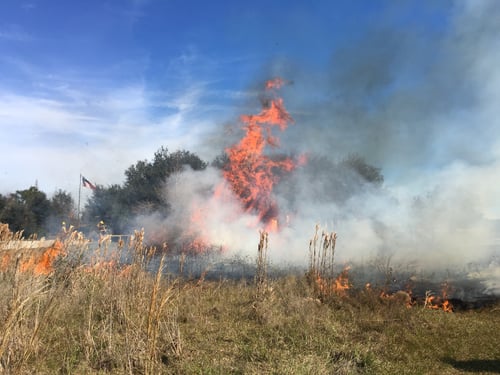When touring the headwaters of the Florida Everglades on one of our airboats, you may have seen one of our favorite parts of native Florida. Not just the headwaters of the Florida Everglades, but a real working cattle ranch.
Brahman cattle are something you're sure to see on the ranch, and this time of year you may see evidence of a prescribed burn, too.

While prescribed – or controlled – burns take place today, they actually have a deep roots in southern history. The practice of these type of burns dates back to Native Americans and was later adopted by early European settlers. First used to control brush and timber, provide better access to other areas, and improve hunting, prescribed burns still do much of the same today.
But why are these types of fires necessary? They actually provide many benefits to Florida's ecosystem and even provide protection for locals and their homes. Here are just a few reasons why these burns are necessary...
- Insect or disease control—Plants can sometimes become infected by disease (whether from an insect infestation or something fungal), and prescribed burns are a way to control and reduce these problems. Oftentimes a prescribed burn can prepare the site for reforestation and removal of infected debris.
- Wildlife habitat improvement—Prescribed burns are one of the best ways to improve wildlife habitats because shrubs and other plant life experience a burst of new growth following the fire. Many times this new growth is more nutritious to the various grazing wildlife in the area.
- Native vegetation regrowth—To start, flowers, seeds, and fruit production increase after a prescribed burn. Sometimes, though, a prescribed burn can do things like reduce the density of the existing vegetation, which in turn allows more sunlight to come through, spurring growth of grasses and other low lying vegetation.
- Appearance improvement—these types of burns can improve recreation and aesthetic aspects of an area. Prescribed burns can be used to manage landscape growth and enhance scenic views in areas where the vegetation has become overgrown, etc.
While prescribed burns are necessary for Florida's ecosystem, it is important that they are done carefully. Only experienced professionals should oversee a prescribed burn, as they manage a wide variety of factors during the burn, including fuel load, wind speed and direction, humidity levels, temperature, and the proximity of the property to areas such as roads, schools, hospitals, and homes.
You may be wondering what happens to the wildlife that lives in the area of the prescribed burn during the fire. There is really no need to be concerned with these animals and their safety. Wildfires happened long before people came in and started doing them in a controlled setting, which means animals instinctively know what to do when it comes to this particular danger. Wildlife innately know to escape the area as the fire spreads, but not all animals will flee from the fire. Birds will fly away, and many land animals will walk or run, but some animals will burrow underground or even return to the fire very soon after it has passed to forage and hunt.
A few other interesting facts related to prescribed burns in Florida?
- The Florida Forest Service issues around 120,000 authorizations allowing land owners and agencies to burn an average of over 2 million acres each year.
- Florida was one of the pioneers in offering a certified burner program for both acreage burns and pile burns.





